Chapter 1 Interior Of Earth
1. The Earth our homeland is one of the members of the Solar system. The earth is a planet. Among all planets of the Solar system as well as the Universe, the earth is a unique planet because it contains life and it is possible for these main reasons—air (atmosphere), water (hydrosphere) and soil or rock (lithosphere).
Read and Learn all WBBSE Notes For 8 Class Middle School Geography
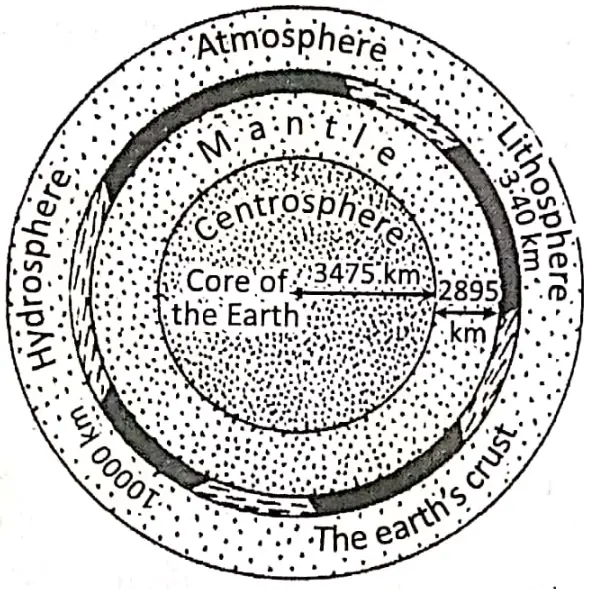
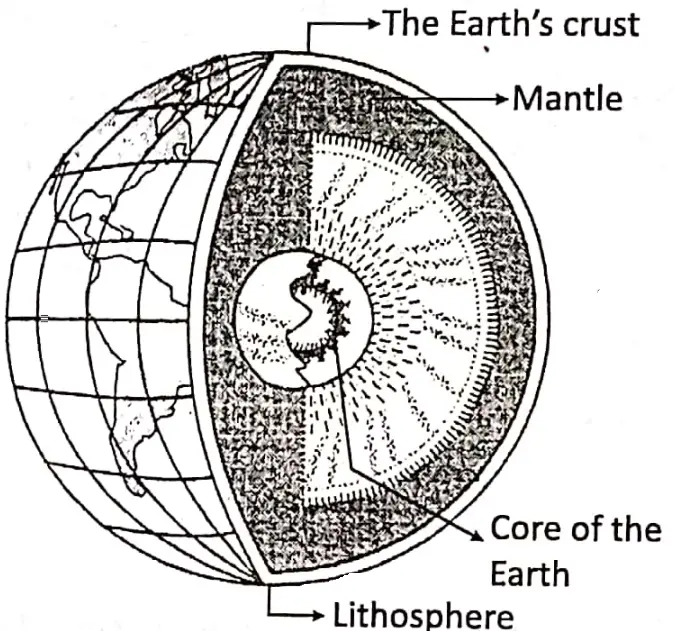
2. Some scientists believe that about 4600 million (460 crores) years ago, the earth was born as a gaseous ball. As the earth has been cooled for millions of years, most of its components slowly condensed to form liquids. When it passed through a molten stage light substances floated up from deep inside to lie upon its fiery surface. Then they cooled and hardened.
3. This hard outer layer of the earth is called the ‘earth’s crust’. |f a cup of hot milk is kept, a creamy layer is formed on the top when it cools down, but just below the creamy layer, the milk remains liquid and hot for a few minutes. So the interior of the earth is still in a liquid state which we can realise from the occasional eruptions of the volcanoes.
Information regarding the earth’s interior: Exploring the earth beneath our feet is a more difficult task. If we want to know what lies hidden in the centre of the earth we should able to dig up a borehole to the centre of the earth from the surface of the earth whose length is about 6400 kilometres (the radius of the earth is 6368 km).
Although man has not been able to sink boreholes more than 8 km into the earth’s crust. He is able to obtain information on the nature of the earth’s interior by studying molten materials (magma/ lava) emitted from volcanoes and by studying the behaviour of seismic waves (earthquake waves).
By using a seismograph, a graphic recording of earthquake waves, scientists are able to get some idea of the kinds of rocks which are found below the earth’s surface. We need its elementary knowledge in Geography because this understanding is essential to follow the nature of changes taking place on the earth’s surface.
Temperature and pressure inside the earth: The evidence of volcanic eruptions and hot springs indicates that high temperatures prevail in the interior of the earth. A progressive rise in temperature with increasing depth is recorded in mines and deep wells all over the world, the average rate of increase being 1°C for every 32 metres of descent.
At the same time, there is a tremendous increase in the pressure of overlying layers on the earth’s interior. Thus, even under extremely high temperatures towards the central part of the earth, the liquid nature of its core has acquired the properties of a solid and is probably in a plastic state.
Geothermal Energy: The energy that is derived from the internal heat of the earth is called ‘geothermal energy’. The temperature increases with depth at approximately 1°C for every 32 metres, some of this heat is transported to the surface by geysers, hot springs and volcanoes.
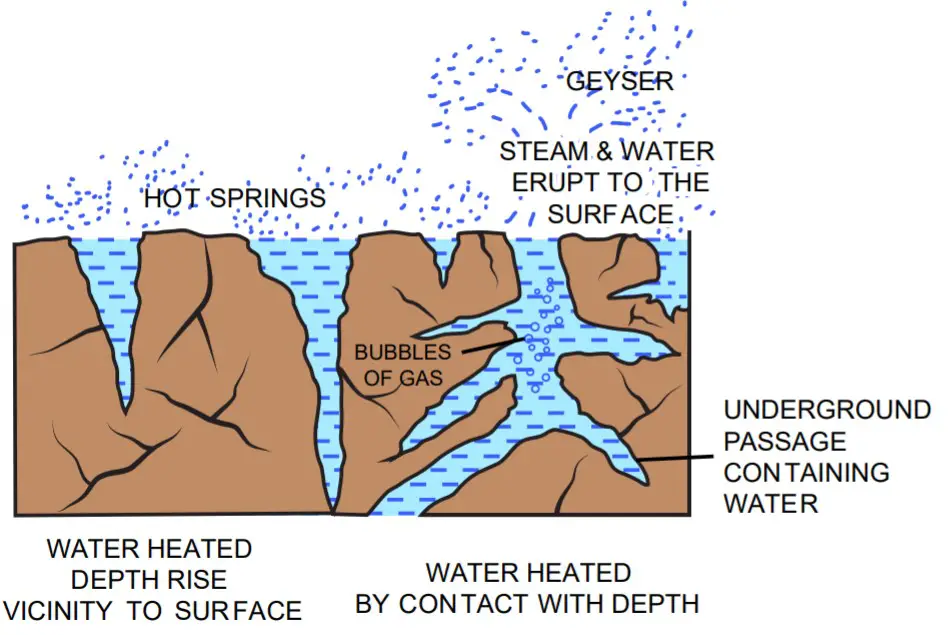
What is magma: Molten rock materials charged with gases and at a very high temperature lying beneath the earth’s surface is called ‘magma’.
What is Lava: Molten or particularly molten magma that is extruded from a volcano or volcanic fissure out onto the surface of the earth, where it cools and solidifies is called ‘Lava’.
Distinguish between Magma and Lava:
| Magma | Lava |
| (1)Magma is hot, sticky molten material the interior earth. | (1) Lava is solidified form of magma on the surface of the earth. |
| (2)It contains solutions of water and gases. | (2)Gases and water disappear after evaporation. |
| (3)It comes out during volcanic eruptions. | (3)It cools down as it comes into contact with atmosphere. |
Hot spring: A spring of hot water that flows out of the ground is called a hot spring’ Unlike a geyser, the water is not forced out under great pressure and flows continuously instead of intermittently. In many areas hot springs are associated with past or present volcanic activity. They are also found in non-volcanic areas. In India hot springs are found in Rajgir (Bihar), Bakreswar (West Bengal) etc.
The density of the Earth: The mass of a substance per unit volume is called ‘density. It is expressed in gm/cm3. It helps to give the idea of how closer or farther the molecules and atoms of a particular matter exist. The average density of the earth’s surface is only 2-6 to 3-3 gm/cm3. The average density of the core of the earth is about 11 gm/cm3. It increases up to 13 to 14 gm/cm3 at the centre of the earth. In respect of artificial satellites average density of the earth is 5-5 gm/cm3.
Seismic Waves: There is a change in the course and velocity of the waves on crossing the boundaries of different zones inside the earth. If the ground through which the waves travel is solid, they behave in one way. If it is liquid the waves behave in a different way.
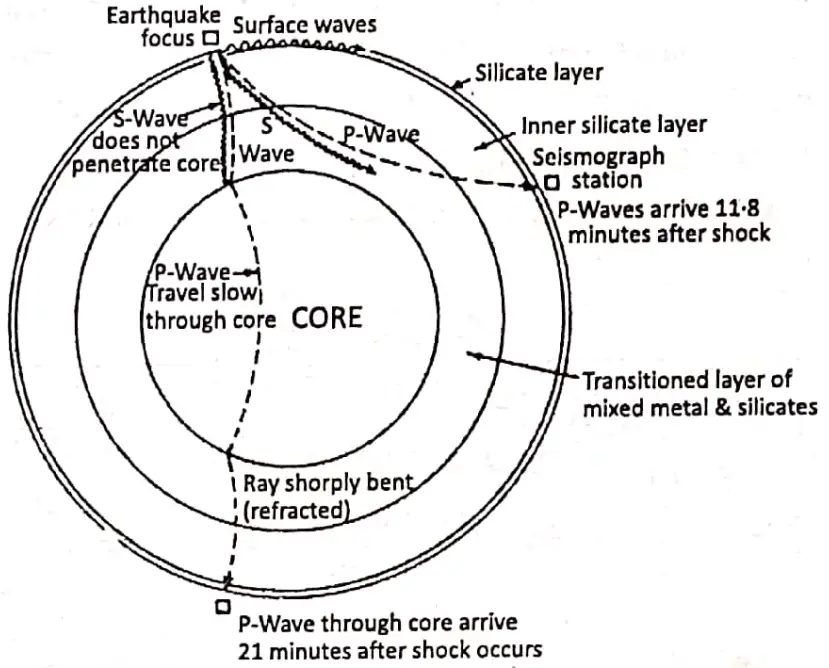
Their velocities in both cases differ There are three types of waves known as ‘P’ or longitudinal or Primary waves, ‘S’ waves or transverse or secondary waves, and the long ‘L’ waves or surface waves which are recorded by a seismograph. The velocity of the first two types of waves increases with depth but only up to 2900 km.
Afterwards ‘S’ waves passing accorss the direction of their movement do not pass the ‘P’ waves travelling in the direction of their movement generally pass at a recorded velocity. The long ‘L’ waves do not pass and do not go deeper in the earth.
The ‘S’ waves cannot pass through a liquid and are transmitted only through a rigid or a solid body. The velocity of the ‘P’ waves passing through inner core again increases as compared to their passage through inner core again increases as compared to their passage through the outer core.
Layers of the Earth: At present, by observing the seismic waves and the lava coming out of a volcano, scientists have identified three concentric layers in the earth’s -interior from the surface of the earth to the core or centre of the earth. These layers are ‘the crust’ (lithosphere), ‘mantle’ and ‘core’ of the earth.
(1) Lithosphere: The word ‘l*’tho’jn Latin -means ‘rocks’ or stone. The word lithosphere thus means a ‘rocks sphere’. lt is rightly called the ‘rocky skin’ 0f the earth. Lithosphere is the outermost solid layer of the earth. It is found both on the continents and in oceans.
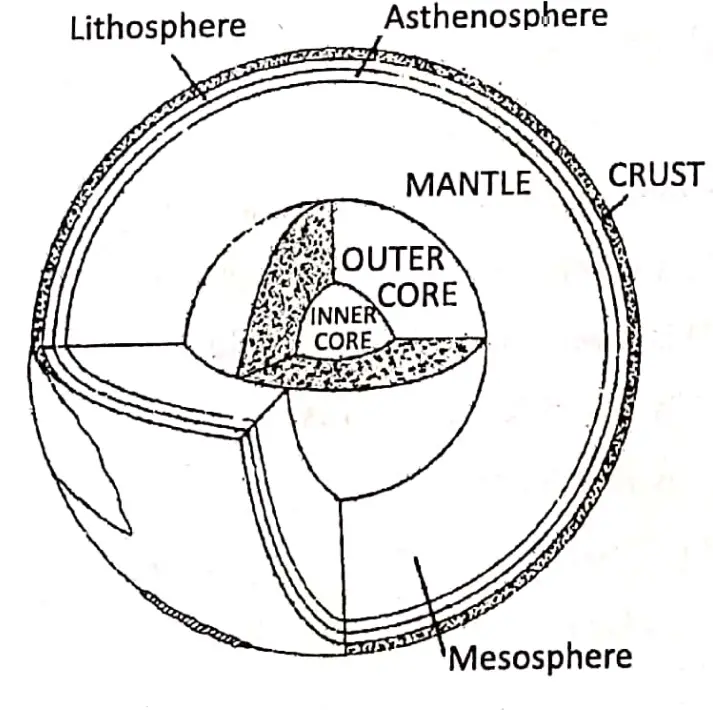
It forms a thin crust (the earth’s crust). The average thickness of the lithosphere is 60 km. It is spread over 29% of the earth’s surface. The thickness of the lithosphere is greater on the continents than on the ocean floor. The rocks of this crust are of lower density than those below the crust.
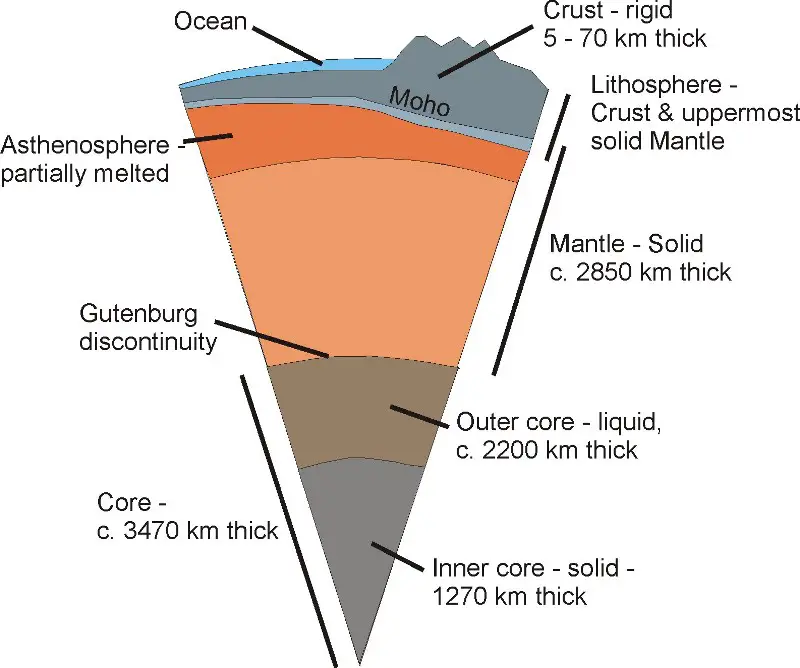
The crust of the earth: The outer part of the lithosphere immediately below the. newer sedimentaries on the surface is called ‘the crust of the earth’. The earth’s crust is now regarded as a series of plates which are gradually being pushed apart, away, from the zone where they formed. This layer is composed of light materials like silicon, aluminium, magnesium etc. The crust has two distinct parts.
These are—(1) sial and (2) Sima.
(1) Sial: This is the uppermost layer of the earth. This layer is called the ‘crust of the earth’. Silica and aluminium predominate in this layer and hence it is also called Sial (Silicon = Si and Aluminium = Al) Though it is composed of light rocks, its density is only 2-75g/cm3.
The principal rock of this layer is granite. In some places ‘Sial’ is 60 km thick. Continents have been formed by this layer and it is also called ‘continental crust’. This layer is absent in ocean floors.
(2) Sima: This layer is found below the layer of Sial,’ It has an average thickness of 6-8 km. and a density of 3 g/cm3. This layer is composed mainly by Magnes (a). So it is called Sima. This layer forms the ocean floors. So it is also called the ‘oceanic crust’.
Sima layer is about 5km thick and the principal rock of this layer is basalt. Though these two layer is in a solid state, the lighter ‘Sial’ is considered as ‘floating’ on the denser ‘Sima’ layer.
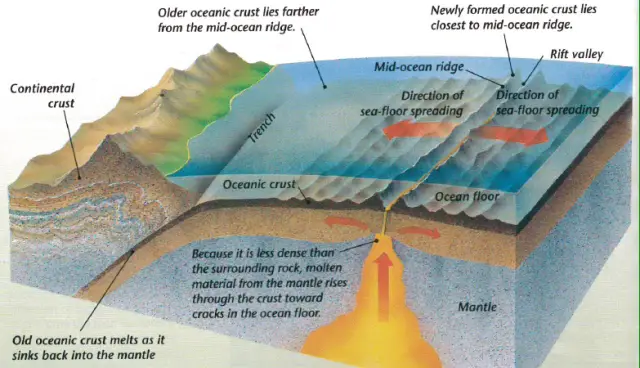
Distinguish between ‘Sial’ and ‘Sima’:
| Sial | Sima |
| 1. The upper part of the earth’s crust. | 1. Sima layer lies below the Sial layer. |
| 2. It is composed of SiOica and aluminium. | 2. It is composed of Silica and Magnesium |
| 3. Continents are made of Sial. | 3. This layer forms the ocean floors. |
| 4. It is called ‘continental crust’. | 4. It is called ‘Oceanic Crust’. |
| 5. It is lighter than Sima. | 5. It is heavier than Sial. |
| 6. Principal rock of this layer is granite. | 6. Principal rock of this layer is basalt. |
| 7. This layer is about 60 km thick in some Places. | 7. This layer is about 5 km. thick. |
| 8. Specific gravity is lower than Sima. | 8. Specific gravity is higher than Sial. |
Discontinuity Line: The line of limit or boundary between two layers within the Earth that possess very different physical properties is called discontinuity Line’. These boundaries were discovered by the study of the behaviour of seismic waves as they travelled through the heart.
Conrad Discontinuity: The line of limit or boundary on which the lighter granite made a lower portion of continental mass (Sial) joins the heavy basaltic ocean floor (Sima) is known as ‘Conrad Discontinuity’.
Mohorovicic/MohoDiscontinuity: Thelineoflimitorboundaryinbetweenthecrustofthe earth (lithosphere) and the Mantle (Mesosphere) is called the ‘Mohorovicic’ or ‘Moho Discontinuty’.
Repetti Discontinuity: The line of limit or boundary in between the ‘Crofesima’ and ‘Nifesima’ is called ‘Repetti Discontinuity’.
Gutenberg Discontinuity: The line of limit or boundary in between the Centrosp ere (core) and Mesosphere (Mantle) is known as the Gutenberg Discontinuity’.
Lehman Discontinuity: The line of limits or boundary in between the inner core and the outer core of the earth is called’Lehman Discontinuity’.
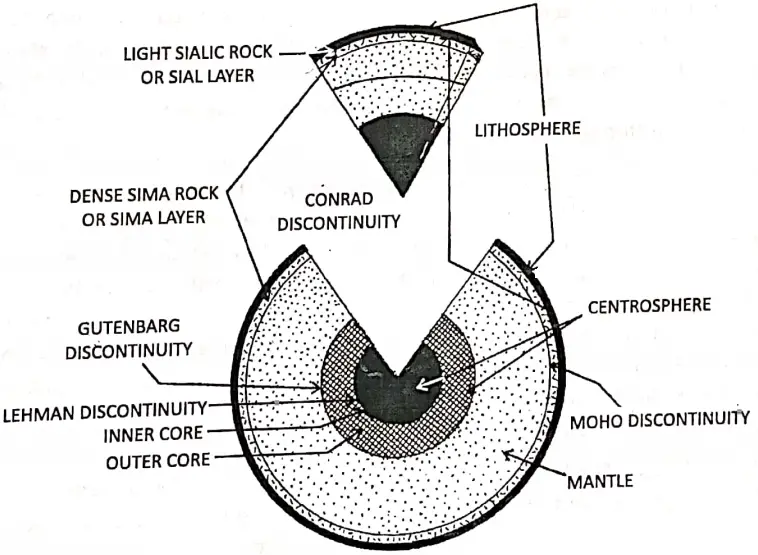
Significance of lithosphere to man: Lithosphere is useful for man in many ways
- Lithosphere provides land for human settlements.
- Soils of the lithosphere are indispensable for the growth of plants and crops.
- Many types of minerals and fuels are found in the lithosphere.
- Atmosphere is heated up by radiation from the lithosphere.
- Lithosphere is responsible for the exchange of water from oceans to atmosphere.
Chapter 1 Interior Of The Earth: Mantle
Asthenosphere: That portion of the interior of the Earth lying beneath the crust (lithosphere) and above the core (centrosphere) is called ‘Mantle’or ‘Mesosphere’. Its upper limit is the Mohorovicic discontinuity, which lies at an average depth of 35-40 km below the surface of the earth, and it descends as far as the Gutenberg discontinuity which lies about 2900 (2895) km. This layer is composed of nickel, iron, silicon, magnesium etc.
The specific gravity of this layer is about 4 to 5. Temperature of this layer is about 2000°C much less than the core but quite higher than lithosphere. The mantle is subdivided into two layers—(1) Outer Mantle or ‘Crofesima’ and (2) Inner Mantle or ‘Nifesima’.
The upper part of the mantle (40 to 700 km) is composed of chromium (CRO), (Ni) iron (fe), silicon (Si) and magnesium (Ma) and the lower part of the mantle is composed of nickel, iron (fe), silicon (Si) and magnesium (Ma). i.e. 700 to 2900 km (2895 km).
Volcanic eruptions originate in the upper part of this ‘Crofesima’ layer. This layer is also significant in the formation of fold mountain, earthquakes, continental drift etc. This part of the mantle is known as the ‘Asthenosphere’ (Asthenosphere is a Greek word, which means ‘weaker layer’).
Due to excessive heat and pressure, the rocks are here in a state of viscosity—just as molasses or melted asphalt. Comparatively lighter materials come upwards when heated geothermally, and allow the heavier ones to go downward. This is happened to be a sort of convectional current. From this part of the mantle molten rocks or magma find their way to the earth’s surface through cracks or faults.
Chapter 1 Interior Of The Earth: Centrosphere or Barysphere or Core of the Earth
The central portion of the Earth’s interior is called the ‘core ‘barysphere'(‘bary’ from greek word ‘baros’ meaning weight). The innermost layer which encircles the centre of the earth is also called the ‘core’ or the mental is the centrosphere.
This layer extends from the centre of the earth to about 3500 (3475) km. This is the hottest, heaviest and densest layer of the earth’s interior and is composed mainly of nicloel (Ni) and iron {fe) which gives its name ‘NIFE’ or ‘Nife’.
The density, of the core, is between 10 – 12 gm/cm3. So this dense layer is also called the ‘Barysphere’. The temperature of the core is estimated at 5000°C. Geologists have divided the core into two sub-layers— (1) Inner core and (2) Outer core.
- Inner Core: The layer that lies surrounding the centre of the earth is called the ‘inner core’. It is nearly 5100 km to 6368 km deep. The tempereture of this layer is about 2700°C and at very high pressure. This layer remains in a solid state.
- Outer Core: The layer which encircles the inner core is known as ‘the outer Core’. It is nearly 2895 (2900) km to 5100 km deep. The outer core does not transmit the ‘S’ waves of earthquakes, which suggests that it is liquid.
Temperature, pressure and specific gravity of the inner core are much higher than of the outer core. Outer core is in a molten state because of high temperature. But the inner core is solid probably due to the tremendous pressure of the overlying rocks.
WBBSE Notes For 8 Class Middle School Geography
- Chapter 2 Unstable Earth Notes
- Chapter 3 Rocks Notes
- Chapter 4 Pressure Belts And Winds Notes
- Chapter 5 Cloud And Rain Notes
- Chapter 6 Climatic Regions Notes
- Chapter 7 Human Activities And Environmental Degradation Notes
- Chapter 8 Some Neighbouring Countries Of India Notes
- Chapter 9 North America Notes
- Chapter 10 South America Notes
- Chapter 11 Oceania Notes

